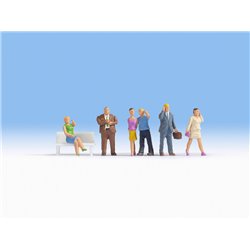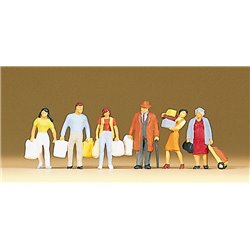Mainline Railways was a British model railway brand that operated between 1976 and 1983, introduced by Palitoy, the...
No products
Product successfully added to your shopping cart
There are 0 items in your cart. There is 1 item in your cart.
Search Tips
Easter shipping
Please note that couriers are not collecting on Friday 18th and Monday 21st April.
Orders will be dispatched on Tuesday 22nd April
What is meant by 'Bringing life to your layout or scene'?
Often, railway modellers talk about the importance of bringing their scene to life, but what does this mean? and why is it important?
Bringing a scene to life when everything in that scene is motionless is not an easy task. What you are trying to do is suggest activity, movement or situation even where there is none. This can be achieved using a few props and thoughtfully placed figures to hint at what your miniature people and vehicles would be doing if they could move.
Figures and vehicles are often placed on a layout to merely fill space or casually represent people with little regard to what they're doing or where they're going, and that's a good start, after all, any real street or station will feature many people and vehicles that give absolutely no indication of what they're up to and this anonymity should be modelled.
But saturate your scene with anonymity, and it could start to replicate a scene from a zombie movie. Real people when visiting a high street or using a railway station are likely to participate in activities other than walking or standing and encounter all sorts of situations, whether it be browsing in a shop window, chatting to a friend, crossing a road, dodging some scaffolding or queuing for a bus. On an average high street, you will also find workers busily delivering packages, erecting billboards, fixing or cleaning infrastructure and enforcing rules.
Recreating such scenarios on your layout will give your figures purpose and hint at their activity. This will not only better replicate real-life and bring the scene to life, but, also provide a more interesting scene for the viewers, whether they be at a show, a visiting friend or even the layout's creator during a quick play or running session.
A small scene within a scene that is created to suggest an activity or situation is known as a cameo scene and is the best way to suggest movement or life in a static display, roadworks, for example, provide something for workers to do, parked cars validate the presence of a parking warden, a pedestrian crossing turns walking people into crossing people and a bus stop turns standing people into queuing passengers.
Include a few cameo scenes on your layout and before you know it your once generic figures will be shoppers, builders, traffic wardens and passengers all displaying activity and life and all telling a story.
Click here to receive the tips weekly in your mailbox. You can unsubscribe at any time.










